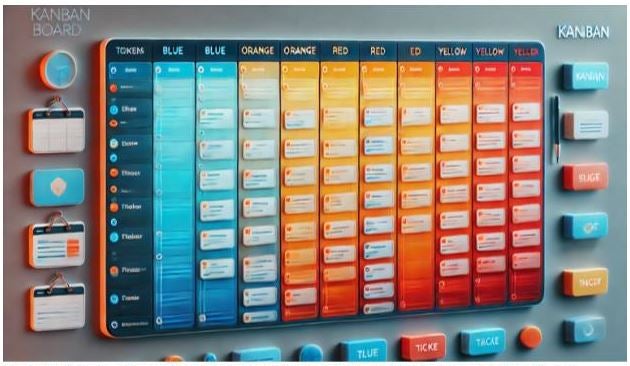Customized Scrumban: A Hybrid Approach to Agile Development
Marcin Sadowski - Senior Delivery Manager
27 Sep 2024

Introduction
Scrumban is a hybrid agile framework that combines the structured process of Scrum with the flexibility of Kanban. Projects have adopted this framework to benefit from the best of both worlds: the predictable planning cycles of Scrum and the adaptive workflow management of Kanban. This method allows for enhanced visibility into the workflow and the flexibility to adapt to changing priorities and requirements as they arise. Personally, I have found this framework extremely helpful in my daily assignments. This is my own point of view based on using it regularly, and it may differ from other perspectives you can find on the internet. However, this doesn’t mean that a customized Scrumban is necessarily better than pure Scrum or Kanban. It’s about choosing the right tool for the specific type of project. Every project is different, and we should always strive to find the best possible approach to achieve success.
Key Features of Scrumban
Unlike traditional Scrum, Scrumban removes rigid constraints such as fixed iterations and burndown charts, giving teams the ability to manage their workflow in a more flexible manner. Here are the key features that make Scrumban an attractive option for agile teams:
1. Flexible Iterations:
Scrumban doesn’t enforce fixed-length sprints. While Scrum traditionally advocates for 1–4-week sprints, Scrumban allows production to take as long as needed to achieve the best results. Teams can adjust their workflow dynamically, ensuring that there are no bottlenecks and that tasks are completed based on just-in-time principles.
2. Pull-Based System:
In Scrumban, work is pulled into the process as capacity becomes available, instead of being pre-planned at the beginning of a sprint. This pull-based system helps to ensure that the team remains productive and reduces downtime when waiting for more work. Still core deliverables should be identified during iteration planning.
3. Visual Workflow Management:
Scrumban uses visual boards, similar to Kanban, to track the progress of tasks and manage workflow stages. Unlike a traditional Kanban board, Scrumban boards typically have more stages to represent the gradual progress of tasks, aligning more with the Scrum sprint planning approach.
4. Focus on Eliminating Bottlenecks:
By focusing on removing bottlenecks and improving flow, Scrumban ensures that work progresses smoothly without getting stuck at any stage of the development process. Continuous monitoring of workflow helps to identify potential blockers before they become significant issues.
5. No Burndown Charts, No Backlog Owner:
Scrumban emphasizes keeping the backlog visible to all team members and encourages teams to collaborate and refine the backlog regularly. Each backlog item has its owner. If a task is more complicated, it should be broken down into subtasks and assigned to the appropriate team members
Why Scrumban?
There are several key advantages in adopting Scrumban:
• Higher quality of work: By not being restricted to short iterations, teams can focus on delivering fully fleshed-out increments of work.
• Increased speed: The pull-based system allows teams to start new work immediately when capacity becomes available, minimizing delays.
• Minimized waste: Teams work on what is needed when it’s needed, reducing unnecessary tasks.
• Happier teams: Empowered to control their workflow, teams can adapt processes to their needs, leading to improved morale.
• Continuous improvement: The iterative and flexible nature of Scrumban allows teams to experiment and refine processes as they progress.
Initial Steps for Implementing Scrumban
To implement Scrumban effectively, you should consider taking the following steps:
1. Develop a Scrumban Board
Teams use the board to visualize the workflow, track progress, and ensure transparency.
2. Set Task Limits
A limit is agreed upon for how many tasks can be active at any time, helping to focus efforts and prevent overloading team members.
3. Prioritize the Backlog
The project backlog is regularly refined, ensuring that the most critical tasks are always visible and prioritized.
4. Agreed Ways of Working
Teams mutually agree on the structure for communication, including daily stand-ups and regular review meetings.
5. Milestone-Based Planning
Rather than working within the constraints of sprints, Scrumban focuses on reaching significant project milestones through agreed-upon rounds of work in iterations (timelines and estimations should be applied).
The Flexibility of Iterations
One of the most significant benefits of Scrumban is its flexibility in iteration length. The framework offers the option for iterations of varying lengths based on the complexity of the work and the team’s capacity.
Each iteration should consist of core planned elements, typically the deliverables that align with the project’s milestones and timeline. However, to avoid idle time and wasted resources, teams can pull in additional tasks as they become available. This dynamic adjustment ensures that team members are not left waiting for work, maintaining momentum and productivity throughout the iteration.
In addition, iteration lengths can adapt to the project’s evolving needs. If a task requires more time than initially anticipated, the iteration can be extended to accommodate it without sacrificing quality or increasing pressure on the team. This flexibility helps maintain a high standard of deliverables while allowing the team to respond quickly to changing project requirements.
Why Kanban as a Foundation?

Using Kanban as a foundation allows me to visualize work, limit work in progress (WIP), and manage the flow of tasks through the system. Kanban encourages teams to:
• Make process policies explicit so everyone understands how work is done.
• Continuously improve workflows through feedback loops.
• Manage work efficiently, eliminate waste, and optimize productivity.
Communication Plan
To support the smooth implementation of Scrumban, I established a detailed communication plan, which includes – looks familiar? ;)
1. Daily Stand-Up Meetings
Short, daily meetings to update team members on progress and discuss any roadblocks.
2. Weekly Status Review Meetings
Weekly meetings to review completed work and plan the next tasks in the queue.
3. Scrumban Retrospective and Demo Meetings
End-of-iteration meetings to reflect on the work done, evaluate successes and challenges, and showcase deliverables to stakeholders.
4. Monthly Status Reports
Optional monthly status reviews to assess long-term progress and identify any emerging risks.
Summary
This article is a summary of my own experience, mixed with the knowledge I’ve gained about Scrumban. By blending the best practices, you are empowering teams to work more efficiently while maintaining high-quality standards, minimizing waste, and ensuring continuous improvement. This framework can be an interesting alternative for project managers who are currently in the process of choosing the right approach for commencing a project. Hybrid approach provides the flexibility to adapt best practices to your current needs and circumstances, making it a highly customizable solution that can fit various project environments.

Marcin Sadowski
Throughout his career, Marcin has proven to be a valuable asset to every team he has worked with, having gained expertise in various areas of the IT field. During the first seven years of his career, Marcin worked as a Java, ABAP, and full-stack .Net developer. This experience allowed him to gain an in-depth understanding of software development and become experienced in programming languages and tools used to build complex software solutions. His knowledge of development best practices and methodologies and consultative approach have proven to be invaluable in his later roles.
As he progressed in his career, Marcin transitioned into leadership roles, taking on various positions such as Line Manager, Project Manager, Operations Manager, and Director of various departments. In these positions, he demonstrated exceptional leadership skills, enabling him to manage teams effectively and achieve optimal results.
Marcin has been instrumental in successfully delivering complex IT projects, managing teams of various sizes, and optimizing processes to improve efficiency and productivity. He has also worked with clients from various industries, demonstrating his adaptability to different environments and the ability to build strong relationships with clients.



Share on social media